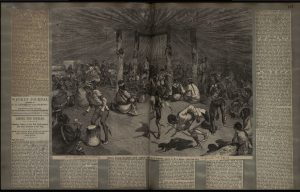Music and dance are two things that have gone hand in hand since early times. We all have had our experience of dancing. Whether it is a high school dance, prom, party’s, or other similar events. Where the unique aspect of dance begins is when it is attached to more than just music. For the Native Americans dance and movement went hand and hand with beliefs. It was used for religious events, spirituals, and celebrations that tied heavily into the culture. We know this by accounts from those who witnessed and the ones who kept traditions alive through the generations. The descendents of those Natives later would tell their stories and ways to outside individuals to keep them alive and remembered but this is where we get to the part that stuck out to me. This part of their culture is so unique and interesting because it is so different from other forms of movement that we see predominantly. Ballet, point, and the other modern forms are very elegant and people associate them with elegance. The dances and ceremonies of the natives struck people as odd and barberic. When they were just as beautiful and important. They were important to the Native Americans and they should not be viewed as barbaric or odd. Unique is a better way of viewing them. They still must be respected because they are fellow human beings. So were the people that were taking in this knowledge also thinking this way. Did The ones who were drawing the pictures or making the accounts actually want to honor this from the natives view and do what the natives said to fully honor and respect their culture? Or are they just doing it their way and framing it in the way that they are doing it the right way when they actually are not fully or not entirely at all respecting the weight behind the culture. The image that I found on the Indigenous Histories and Cultures in North America archive is that of Native Americans dancing. The document which the image was found was in Ely Samuel Parker’s Scrapbook Volume 5. Ely Samuel Parker who was a United States Army officer and Commissioner of Indian affairs. However the image was drawn by William Allen Rogers who was a white American who drew political cartoons and was most known for that. That brings to light the question of did WIlliam Allen Rogers capture the true image that took place that day. Did he capture the image that he saw that day or did he try to capture what the Native Americans saw. Can he truly be a reliable primary source when he later went on to illustrate propaganda that is known to blow things out of proportion or bend that truth. This is the question that must be asked and will lead to making sure that primary sources are reliable or that more than one perspective is drawn.
Parker , Ely Samuel. “Ely Samuel Parker Scrapbooks: Vol 5.” Indigenous Histories and Cultures in North America . Accessed September 19, 2024. https://www.indigenoushistoriesandcultures.amdigital.co.uk/Documents/Detail/indian-dance-standing-rock-agency/7035911?item=7035972&sessionId=&sessionENC=HUjPtMLH8w2WSLX%2beOQlZ9ZgEJDdB4yGOriihUGNuSnJhMsmHo5hfBRmLsTGhBiPMkLLwnzhKJlCNX1NH5JNeLi8uA2IJBZ3uXCk9k0nSo8%3d&returnURL=https%3a%2f%2fwww.indigenoushistoriesandcultures.amdigital.co.uk%2fDocuments%2fDetail%2findian-dance-standing-rock-agency%2f7035911%3fitem%3d7035972&JWTtoken=eyJhbGciOiJIUzI1NiIsInR5cCI6IkpXVCJ9.eyJ0eXAiOiJFeHQiLCJkYXRhIjp7IldlYnNpdGVLZXkiOiJ1YXRhaWhjIiwiT3JnYW5pc2F0aW9uSWQiOiIyNTIxIiwiT3JnYW5pc2F0aW9uTmFtZSI6IlN0IE9sYWYgQ29sbGVnZSIsIkFjY2Vzc1R5cGUiOiJGdWxsIiwiV2Vic2l0ZUlkIjoiNTcifSwiZXhwIjoxNzI2ODU3NDk5LCJvaWQiOjI1MjF9.0Sz01yfewqP2ryYurBZKPZqWG8uSs079Y3u6P8WjeWY


Gabe, I really appreciate the question you are asking here: how do we differentiate between trustworthy resources and propaganda? But propaganda can also help us develop ideas around identity construction in American history. In this case, you might reorient your focus away from Native American dance and toward the people who were documenting them. What were their attitudes or agendas? Are there other resources to suggest what their feelings towards American Indians was? Are they outliers or part of a larger trend? You are probing some of these issues in a way that I appreciate.
This blog post is in need of some revision and especially some reformatting. A single block of text like this is imposing, and doesn’t guide the reader through your argument in a nuanced way. It is absolutely necessary that you find a way to break it into multiple paragraphs, each of which provides something unique to the story you are telling.